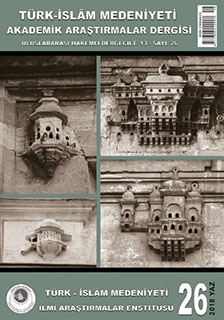Features of Herbal Motifs in Patterns of Workshop Type Sivas Carpets after 19th Century
Keywords:
Sivas Carpet, Herbal Motif, Pattern, Protection of culturalassetsAbstract
The motifs that make up the decorations have various meanings according to the period person and purpose. Many floral motifs, especially flowers, appear to be used in all kinds of works of art to reflect the beauty of human psyche. One of the most used Turkish handicrafts of herbal motifs is carpet. Sivas is one of the cities that good quality hand-woven carpets are woven traditionally. Hand-woven carpets are woven in Sivas in two groups, traditional and work shop type. In this work, which is done for protection and renewal of Sivas carpets and designs, 50 pieces of Sivas carpets designs taken from pattern store in Sivas Semi-open Prison and Penal Institution were examined. After the pattern pages were scanned. They were rearranged with Boria carpet designer soft ware and transformed in to weavable patterns. The characteristics of the most used plant motifs in the designs are determined and their meanings are explained. Herbals motifs were used in 80% of the designs examined. It is concluded that most used herbals motifs are life tree, rumî, şeşberk, leaf, hatayi, goncagül, penç, the fruit motifs such pine apple and pomegranate are least used motifs in 24 different herbal motifs in total on Sivas workshop type carpets.
References
ANONİM, 2017, http://aregem.kulturturizm.gov.tr/TR,50837/somut-olmayan-kulturel-mirasin-korunmasi-sozlesmesi-hak-.html erişim tarihi: 19.11.2017
ARIK, S., 2009, “Türk Dokumacılık Sanatında Nar Motifi”, Uluslararası İnsan Bilimleri Dergisi Cilt:6, Sayı :1, ISSN:1303-5134, s.1-11
ARIT, A., 2013, “Şamanın Kozmik Dünyası”, Ray Yayıncılık. S.95-100, İstanbul.
BAKIR, S., T., 1999, “İznik Çinileri ve Gülbenkoyon Koleksiyonu”. Türk Tarih Kurumu Basımevi S.193, 207, Ankara.
BİROL, A.İ.; DERMAN Ç., 2005, “Türk Tezyin’i Sanatlarında Motifler”, Kubbealtı Neşriyatı s.47-65,113, İstanbul.
BUĞUR, E., 2006, “Malatya Müzesinde Bulunan Halılar”, Ege Üniversitesi, Sosyal Bilimler Enstitüsü, Sanat Tarihi ABD. Basılmamış Y. Lisans Tezi, İzmir.
ERBEK, G., 1986, “Hayat Ağacı Motifi I”, Antika, S. 15, s. 26-35, İstanbul.
ERBEK, G., 1986, “Hayat Ağacı Motifi II”, Antika, S. 16, s. 26-33, İstanbul.
GEZGİN, D., 2010, “Bitki Mitosları”, Sel yayıncılık, ISBN 978-975-570-335-0, s.164. 168, İstanbul.
KAYIPMAZ, F.; KAYIPMAZ, N., 1990, “Erken Dönem Anadolu Halılarından Sivas’ta Bulunan İki Örnek”, Türkiye İş Bankası, Kültür ve Sanat, Y.2, S. 8 s. 64-69, Ankara.
F. KAYIPMAZ-N. KAYIPMAZ N., 1990, “Avar Kilimleri”, Antik&Dekor, S. 7, s. 115.İstanbul.
KESKİNER, C., 2002, “Türk Süsleme Sanatında Stilize Çiçekler Hatai”, T. C. Kültür Bakanlığı Yayınları s.3 Ankara.
ÖZBAĞI, T., 1989, “Ankara İ L Merkezinde Yaşayan Kadınlarda Bulunan Geleneksel Gümüş Takılar Üzerine Bir Araştırma”, Gazi Üniversitesi, Sosyal Bilimler Enstitüsü El Sanatları Eğitimi Bölümü Yüksek Lisans Tezi, s.27-30 Ankara.
SEÇKİNÖZ, M.; AKER, S. A.; KOMŞUOĞLU, S.; MENGİ, A., 1986, “Resim II Süsleme Resmi ve Süsleme Sanatları Tarih”i, Türk Tarih Kurumu Basımevi. S.12 Ankara.
UŞAK, Y., 2008, “Türk El Sanatlarındaki Bitkisel Motifler ve Makine Halısı Baskı Desenlerinde Kullanımı”, Gazi Üniversitesi, Eğitim Bilimleri Enstitüsü, El Sanatları Eğitimi Ana Bilim Dalı, Yüksek Lisans Tezi (Basılmamış), s.75, 80 Ankara.
YETKİN, Ş.; YETKİN S., K. 1959, “İslâm Mimarisi”, İkinci Baskı, s.116, 480
Downloads
Published
How to Cite
Issue
Section
License

This work is licensed under a Creative Commons Attribution-NonCommercial 4.0 International License.







